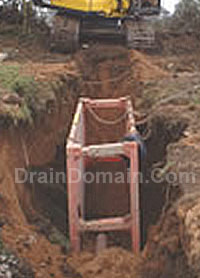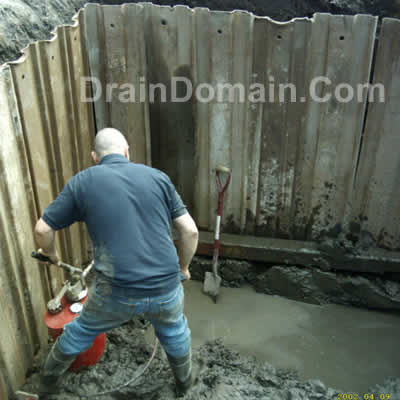
Most Visited
Rats In Your Home
Drain Flies
Why Drains Block
Internal Venting
Who`s Drain Is It ?
Drain Surveys
No-Dig Repairs
Drain Location
Drain Rods Stuck
Find A Contractor
Drain Pipe Work
Clay Drain Pipes
Plastic Pipe Work
Pitch Fibre Pipes
Cast Iron Pipes
Concrete Pipes
Drainage Parts
Drain Gullies
Dropshafts
Interceptor Traps
Soil Vent Pipes
Anti-Flood Valves
Manholes
Drain Repairs
Excavations
Drain Lining
Patch Lining
Pipe Bursting
Re-Rounding
Drainage
Investigations
Drain Surveys
Sonar Tracing
Last updated 11 January, 2014
draindmain.com > site map > trench safety
Trench Safety
Works within highways and footpaths can only be undertaken by NRSWA accredited companies and prior to any works commencing drawings should be obtained from utility companies highlighting the position of any apparatus, if in a domestic setting the site should be checked for signs of services such as stop taps and junction boxes either side of boundary lines. You should also check for gas, water and electric mains entering the property with adequate cable and service detecting equipment being used. An excavated trench is potentially a confined space and therefore requires additional assessment with regards to any dangers this may present, lone working within an excavation should not be undertaken and the working area should always be isolated using a suitable barrier system to protect passers by and the guys on the site. Shallow Or Domestic ExcavationsThe images above and below were taken on a couple of larger projects i have been involved with however the majority of domestic drainage is in the great scheme of things fairly shallow, and you are unlikely to be using trench boxes and trench sheets if you are a DIYer. There is as much danger involved in excavating the first metre (depth) of a dig as there is the next three or four, one of the main reasons is that the majority of things that are likely to spoil your day such as gas, water, electric and cable services will be within that depth. If you have pulled up on site with an excavator, trench box and banks man you would assume that these hazards have been taken into account it is however the guy with the pick axe and wheel barrow looking to repair a defective gully pot that will not have considered where the water or gas main enters the property. There are of course strict guidelines as to where and at what depth any service pipe, cable or duct should be buried both outside and inside of the curtilidge of any property, unfortunately the gangs that installed many of these services were paid by the yard and corners were often cut, it is not uncommon to find gas, water and even electric cables concealed within concrete hard standings or within the sub-base that supports tar-mac or flagged driveways. In the last 15 years there has been a massive installation program with regard to cable communications beneath our highways and footpaths and to some degree these were monitored by various bodies, however once the installation entered the home owners side of the boundary anything went and we find cables inches beneath flower beds and lawns or pushed into joints between flag stones and then covered with sand and cement pointing, we even find the cables lay above ground beneath hedgerows but concealed with leaves and debris. Cutting through one of these cables will not be life threatening but the cost of renewing a section (they apparently can not be repaired so you have to renew complete lengths) will make your eyes water especially if you are not insured. Another issue with domestic excavations is where to store the spoil, if you excavate a metre deep trench and store the spoil at the side you may as well be in a 1.5mtr deep hole when the trench sides collapse and the spoil slides in. There is an old saying used by the canal navies `dig deep, throw well back` presumably for this very reason. Trench Shuttering & Shoring
|
||||||||||
| related pages - | types of pipe work |
| sonar drain tracing | |
| find a contractor | |
 The dangers associated with working within excavations and trenches are numerous and it is vitally important that the risks be assessed and a safe working procedure be adopted.
The dangers associated with working within excavations and trenches are numerous and it is vitally important that the risks be assessed and a safe working procedure be adopted. Trenches collapse for numerous reasons and excavations should therefore be shored for safety reasons, a trench does not have to be in excess of 1200mm deep to be dangerous particularly if you are bending down or crouching in the excavation in order to joint a pipe or pick up the tape measure you have dropped.
Trenches collapse for numerous reasons and excavations should therefore be shored for safety reasons, a trench does not have to be in excess of 1200mm deep to be dangerous particularly if you are bending down or crouching in the excavation in order to joint a pipe or pick up the tape measure you have dropped.
